Ecosystems
Value of Groundwater Ecosystems
Groundwater ecosystems provide important services in the environment. Water is purified through microbial processes that remove pathogens and eliminate chemical contaminants. These ecosystems recycle organic matter transported by water and redistribute energy and matter over areas ranging from a few millimeters to meters. Groundwater also contributes to the sustainability of surface ecosystems. (Danielopol et al., 2003)
Three environments associated with groundwater are discussed here: aquifers (completely subterranean), caves (habitats formed by groundwater), and surface ecosystems (habitats sustained by groundwater).
Aquifer
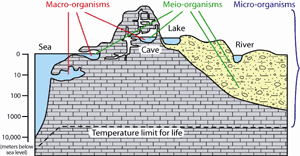
Organisms living underground within the aquifer are subject to extremely uniform conditions compared with surface life. There is very little diversity of habitat type, conditions such as temperature vary only slightly, and darkness is permanent. Species living in groundwaters need special adaptations to survive. Many have elongate body forms to facilitate movement through small openings. The lack of eyes and body pigment is common, as is the increased development of other sensory organs such as antennae. Groundwater organisms are more commonly found near the surface, where oxygen and food are more abundant. This is especially true in the hyporheic zone, the area under and to the sides of rivers. (Scarsbrook et al., 2000)
Caves
Caves are natural openings in rock that are large enough for humans to enter (Gunn, 2004). Organisms that live exclusively in caves are subject to some of the same conditions as those that live within the aquifer, although there is slightly more variation in temperature and habitat type in caves. Because caves are usually larger than most pore spaces within an aquifer, macro-organisms are more common in caves than in the aquifer. Because caves are open to the surface, their faunas are often similar to that of surface ecosystems.
Surface Ecosystems
In many areas groundwater is responsible for maintaining the hydrologic balance of surface streams, springs, lakes, wetlands, and marshes. While rainfall on these areas may be seasonal, groundwater can provide a year-round source of water and prevent the damage that would result from a drought otherwise. Due to the seasonal nature of rainfall in some areas, surface ecosystems may draw groundwater during the dry season and contribute recharge to the aquifer during the wet season. (Fetter, 2004)
References
Danielopol, D. L., C. Griebler, A. Gunatilaka, and J. Notenboom. 2003. Present state and future prospects for groundwater ecosystems. Environmental Conservation 30:104-130.
Fetter, C. W. 1994. Applied Hydrogeology. Macmillan, New York, 691 pp.
Gunn, J. 2004. Encyclopedia of Caves and Karst Science. Fitzroy Dearborn, New York, 902 pp.
Scarsbrook, M., G. Fenwick, and J. Radford. 2000. Living groundwater: studying the fauna beneath our feet. Water & Atmosphere 8(3):15-16.
Cave Organisms
Organisms within caves may occur on the ground, within debris, on the roof and walls, or on any cave formation. Cave organisms are typically divided into troglobites, troglophiles, and trogloxenes (Gunn, 2004).
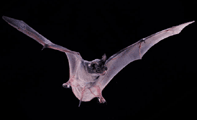
Troglobites live permanently and exclusively in caves. Troglobites generally show morphological and physiological adaptations for life in caves. Such adaptations include the reduction (or loss) of eyes, pigmentation, egg volume, body size, swim bladder, circadian rhythms, scales, and aggression; some troglobites also exhibit increased lifespan (Gunn, 2004). There are nearly 1000 described species of troglobites within the 48 contiguous states of the U.S. and most of these species are known only from a single county (Culver et al., 2000). The caves in the region of the Edwards Aquifer in central Texas contain 108 species of troglobites (Culver et al., 2003).
Troglophiles are species that can live completely underground, but also occur in surface ecosystems. These species typically do not have the modifications seen in troglobites.
Trogloxenes are animals that use caves occasionally but belong to surface ecosystems. This includes bats that sleep and hibernate in caves and carnivores that den in caves.
Aquatic Organisms
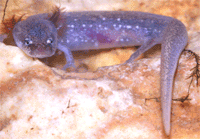
Animal species that live exclusively in subterranean waters are called stygobites. Only about 8% of named species of aquatic animals are known to live within groundwater. This number is so limited because of the limited accessibility of habitats, the homogeneity of the environment, and low amounts of food resources (Sket, 1999). The Edwards Aquifer of central Texas contains a total of 55 stygobite species (Culver et al., 2003)
References
Culver, D. C., L. L. Master, M. C. Christman, and H. H. Hobbs. 2000. Obligate cave fauna of the 48 contiguous United States. Conservation Biology 14:386-401.
Culver, D. C., M. C. Christman, W. R. Elliott, H. H. Hobbs, III, and J. R. Redell. 2003. The North American obligate cave fauna: regional patterns. Biodiversity and Conservation 12:441-468.
Gunn, J. 2004. Encyclopedia of Caves and Karst Science. Fitzroy Dearborn, New York, 902 pp.
Mahler, B. 2004. What’s in the water? The history and future of Barton Springs. Hot Science – Cool Talks #31.
Pollak, G. D. 2004. Seeing the world through their ears: the exotic world of bats. Hot Science – Cool Talks #32.
Sket, B. 1999. The nature of biodiversity in hypogean waters and how it is endangered. Biodiversity and Conservation 8:1319-1338.
Contamination Impacts
Water pollution spans a wide range of chemical, physical, and microbial factors, but over the years the balance of major pollutants has shifted markedly in most industrialized countries. One hundred years ago the main water contamination problems were fecal and organic pollution from untreated human waste. Through improved treatment and disposal, most industrialized countries have greatly reduced the effects of these pollutants. Unfortunately, a new suite of contaminants from intensive agriculture and development in watersheds have taken over.
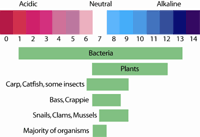
Once pollutants enter an aquifer, the environmental damage can be severe and long-lasting, partly because of the very long time needed to flush pollutants out of the aquifer (UNEP, 1996).
Below is a list of common groundwater contaminants and their impact on ecosystems (from Fraser et al., 1995).
- Excess organic matter: depletes oxygen from the water column as it decomposes, suffocating aquatic life.
- Toxic organic compounds (including oil, plastics, pesticides): various effects ranging from immunity suppression to reproductive failure to death.
- Acidic runoff: acidic water injures/kills aquatic organisms and leaches heavy metals from rock and sediment into water.
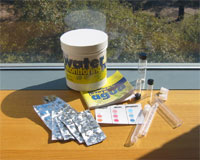
- Dissolved salts: can lead to salt buildup in soils which kills/damages crops; renders freshwater supplies undrinkable.
- Excess nitrates and phosphorous: overstimulates algae growth, which leads to excess organic matter.
- Heavy metals: Accumulates in sediments and organic tissues; toxic to nearly every species.
- Microbial contaminants (such as bacteria): spreads infectious diseases, particularly among vertebrates.
- Suspended sediment: reduces water quality for drinking; interferes with aquatic organisms while spawning, feeding.
- Thermal pollution: decreases oxygen levels in water; accelerates algae growth.
References
BMNRI (Blue Mountain Natural Resource Institute). 1995. Whole Ecosystems in Balance: A Natural Resources Curriculum. Blue Mountain Natural Resource Institute, La Grande, Oregon, 119 pp.
Fraser, A. S., M. Meybeck, and E. D. Ongley. 1995. Water Quality of World River Basins. United Nations Environment Programme, Environment Library 14. UNEP, Nairobi, Kenya, 40 pp.
UNEP (United Nations Environment Programme). 1996. Groundwater: A Threatened Resource. United Nations Environment Programme, Environment Library 15. UNEP, Nairobi, Kenya, 36 pp.